Introduction to Positive Reinforcement Training
Positive reinforcement training is a popular method for teaching puppies new behaviors. This technique involves rewarding your dog when they do something good, which helps them learn what behavior you want them to repeat. Unlike traditional punishment-based methods, positive reinforcement focuses on building up your pup’s confidence through praise and rewards rather than scolding or correcting their mistakes.
The Importance of Consistency and Patience
Consistency and patience are key components in any successful training program. You must be consistent in the way you teach your pup, using clear commands and providing immediate feedback. It’s also essential to remain patient throughout the process, even if progress seems slow at times. Remember that dogs have different learning styles and some may take longer to grasp certain concepts.

Rewarding Good Behavior: How to Use Treats and Praise Effectively
Treats and praise can be powerful tools for shaping your pup’s behavior. Whenever your dog performs a desired behavior, such as sitting on command, give them a treat or shower them with praise. Over time, your pup will begin to associate these actions with positive outcomes and will be more likely to repeat them. However, it’s crucial not to overuse treats during training sessions, as this could lead to dependence and other issues down the road.
Teaching Your Puppy Basic Commands
Basic commands like “sit,” “stay,” and “come” are an excellent place to start when training your pup. Begin by teaching these commands one at a time, using simple steps and plenty of repetition. For example, to teach your pup to sit, hold a treat above their head and say “sit.” As soon as they comply, give them the treat and praise them enthusiastically. With practice, your pup should quickly catch on and respond promptly to these basic commands.
Dealing with Common Problems: Barking, Jumping, Chewing
Even well-trained pups sometimes exhibit unwanted behaviors like barking, jumping, or chewing. To address these issues, consider implementing strategies like desensitization, counterconditioning, and redirection. Desensitization involves exposing your pup gradually to triggers that cause problematic behaviors, while counterconditioning involves replacing negative associations with positive ones. Redirection involves giving your pup an alternative activity to engage in instead of displaying undesirable behavior.
Maintaining a Healthy Relationship with Your Dog Throughout the Training Process
It’s vital to maintain a healthy relationship with your dog throughout the training process. This means setting realistic goals, being kind and gentle in your approach, and avoiding harsh corrections or physical force. By focusing on positive reinforcement techniques and establishing a strong bond based on trust and respect, you can create a happy and well-behaved companion who brings joy to your life for years to come.
Related Questions
What is Introduction to Positive Reinforcement Training and how does it work?
At its core, Introduction to Positive Reinforcement Training refers to the process or practice of Introduction to Positive Reinforcement Training in a defined context. In a simple project you might allocate 5–10 hours to learn and experiment with basic techniques. For example, someone starting out could focus on one key activity and measure how it improves their results. Understanding these mechanics helps you plan budgets, pick tools, and set realistic expectations.
How do you get started with Introduction to Positive Reinforcement Training?
- Research at least two reputable sources to learn the fundamentals of Introduction to Positive Reinforcement Training.
- Gather essential materials and set a small budget (for example, $50) for supplies.
- Create a step-by-step plan and dedicate 30 minutes each day to practice.
- Track your progress in a journal or spreadsheet and adjust based on what you learn.
What tools or supplies do you need for Introduction to Positive Reinforcement Training?
Most projects involving Introduction to Positive Reinforcement Training require a handful of basic tools. A beginner should obtain at least three of the following: a measuring tape or ruler, a reliable container or workspace, and a notepad or digital app for tracking data. Depending on your focus, you might also need a timer or specific handheld tools like a trowel or screwdriver. Starting with these essentials keeps costs manageable and lets you focus on technique.